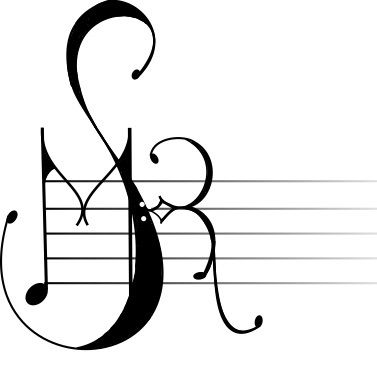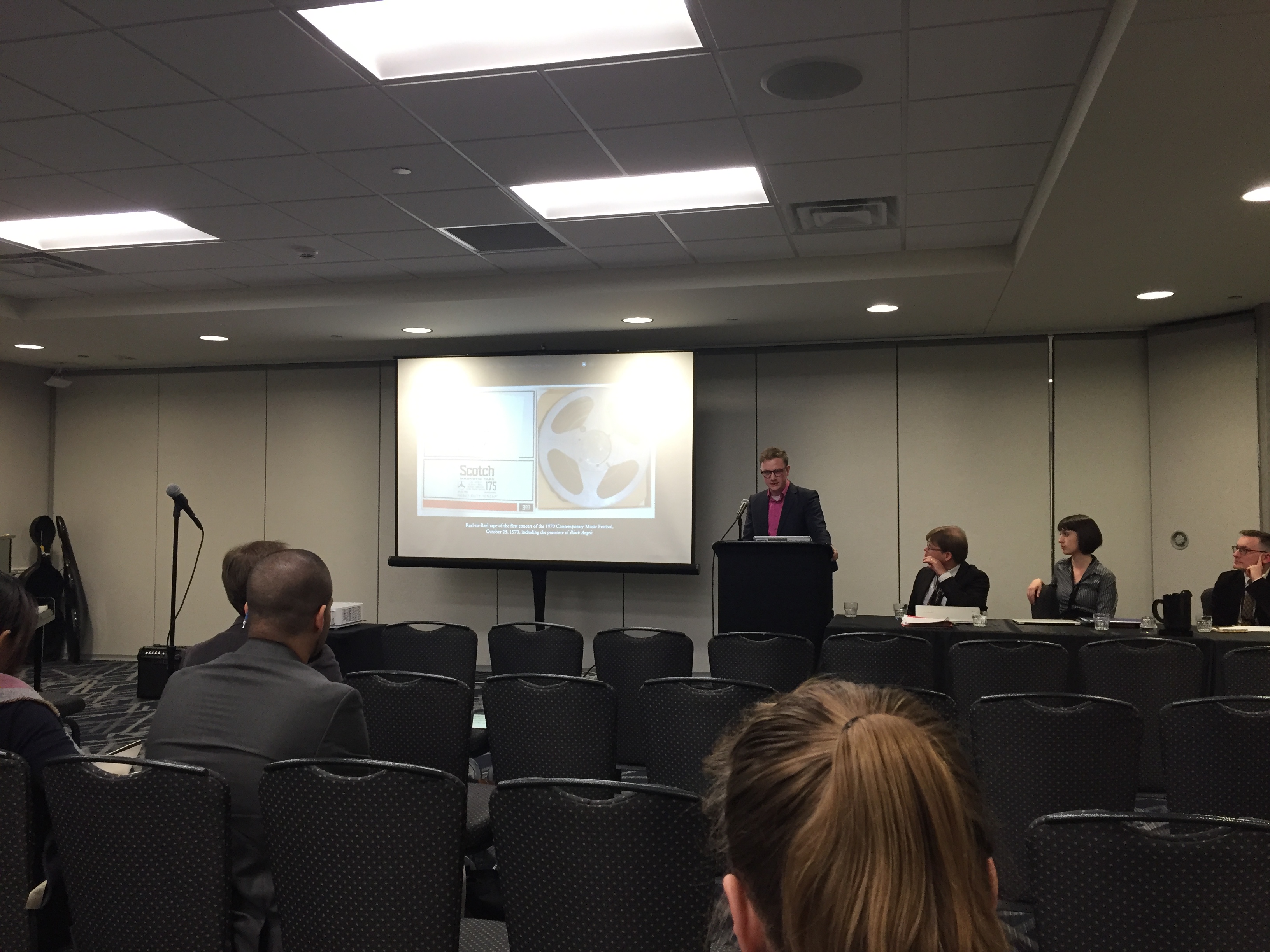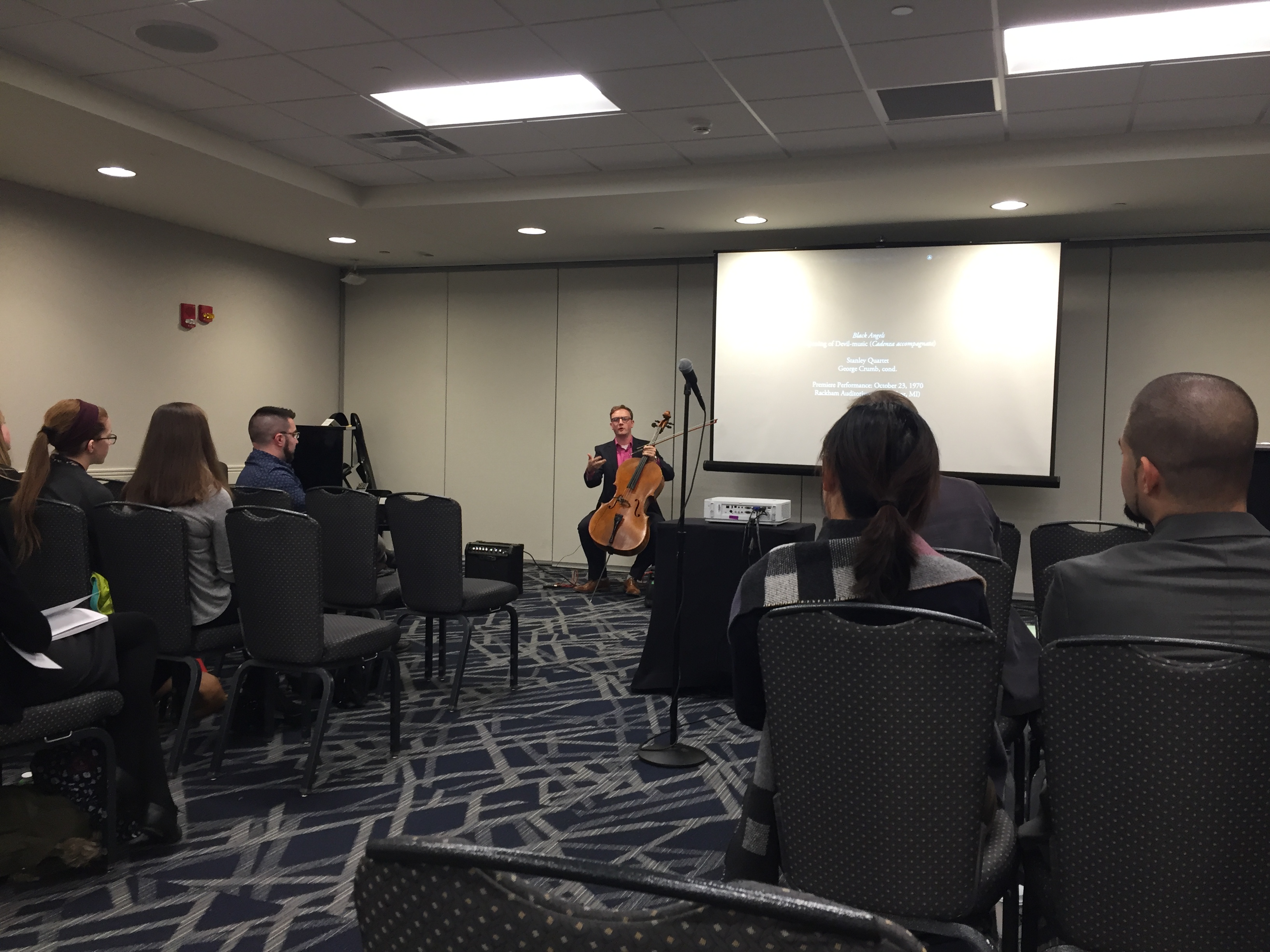
This past weekend, several SMR members were in Columbus, OH for the 2019 annual conference of the Society for Music Theory. Three—Joshua DeVries, Ryan McCulloch, and William van Geest—also gave talks (with the last of these also chairing his session; see abstracts and video below). SMR alumni Stephen Lett and Evan Ware also gave talks, and SMR alumna Vivian Luong co-chaired the meeting of the SMT Queer Resource Group (SMT-LGBT). Besides offering interesting and diverse presentations, the conference served as usual as a great opportunity to catch up with colleagues, prospective future SMR members, and alumni.
Congratulations to Josh, William, and Ryan!
Pictures: Click to enlarge and view captions...
Abstracts:
Joshua DeVries, “'A Wired-Up Quartet'”: Technology and Performance Practice"
In 1970, the Stanley Quartet, conducted by George Crumb, premiered Black Angels. The premiere, recorded on reel-to-reel tape, was recently discovered and matches early reviews: “big electronic sound of a wired-up quartet” (Bloomfield 1971). Early technology could not match Crumb’s expectations— the score instructs one to “avoid distortion of tone,” yet the first recordings sound unrecognizable as string quartets. This timbre reflected the time period, sounding similar to feedback experiments by musicians in other genres, and “contributed to the post-premiere christening of Black Angels as the “Vietnam Quartet.”
As amplification technology progressed towards Crumb’s ideal, differing performance methods arose: one in which the amplification has minimal timbral effect and another in which technology alters the sound. This presentation will first define these methods of performance through demonstrations on the cello, excerpts from the premiere recording, and performance reviews preserved in Crumb’s scrapbooks at the Library of Congress. In order to recreate the early technology, Henry Root, who designed the contact microphones and amplifiers for the premiere, has agreed to devise replicas.
The electronically-heightened performances originate in antiquated technology, and, despite contradicting Crumb’s written instruction, have remained commonplace. Kronos Quartet even has a conscious affinity for it: “It was what we wanted [in the 1970s] and we try to keep it with today’s electronics.” Crumb, when asked about the divergent practices, responded, “The world has so much pain now. We don’t need any more pain.” The second half of this paper will examine how the different methods of performance affect listener perceptions and analytical readings.
Ryan McCulloch, "Shostakovich As Analyst"
On October 12, 1950, Dmitri Shostakovich began a chorale sketch of his Prelude in A minor, the second prelude from the 24 Preludes and Fugues. The work was later reviewed in March 1951 by the Symphonic and Cham- ber Music subcommittee of the Composers’ Union and was temporarily barred from publication. Even the work’s harshest critics, however, could not detect a trace of contradiction or controversy within this prelude. Shostakovich’s sketch of the prelude, however, reveals a number of voice- leading, reduction, and prolongation conundrums, suggesting that the harmony is more ambiguous than a cursory glance would suggest.
Shostakovich the analyst challenges several criteria of reduction, necessitating a few revisions in orthodox reduction practice. To begin with, the sketch employs an inconsistent number of voices. I contend that those instances in which Shostakovich reduced the texture from five to three voices are indicative of registral expansion and contraction within a phrase. Unlike orthodox reduction practice where register is of secondary importance, registral expansion and contraction are fundamental devices the composer used in this sketch. Furthermore, I reevaluate some ineffective criteria for determining chord tones motivated by the dissonant figuration in the score. While some dissonances are straight forward, such as the dual-natured passing tone/neighbor tone in the first bar, many others are more ambiguous (Dolzhansky 1963). I provide two instances in which Shostakovich’s reduction deviates from my own to suggest that chord tones can be established based on voice-leading parsimony and patterning of voicings in the context of the phrase.
William van Geest, "The Chorale in American Music Theory: A Corpus Study of Leading Textbooks"
While music theorists widely acknowledge the chorale’s privileged position in American music theory, very little scholarship critically examines this position. In this paper, I address this omission by presenting a corpus study of leading undergraduate textbooks. I aim through this study not only to establish the prevalence of chorales in undergraduate music theory instruction, but, more importantly, to reveal some particularities of their usage and the commitments this usage encodes.
I begin by investigating chorales’ prevalence. I examine their incidence among musical examples, authors’ purposes in using them, and their distribution relative to particular topics. I also explore authors’ handling of chorales. I demonstrate their preference for four-part, vocal, homophonic chorale-harmonizations by J. S. Bach; but I also discuss their presentation, both visually and aurally, as a texture rather than as a genre, and one abstracted from cultural context and instrumentation. Through an examination of authors’ explicit definitions of the terms “chorale” and “chorale style,” I show the chorale’s close connection to a widely held model of musical structure. Indeed, to all appearances, the chorale in American music theorists’ preferred form is virtually indistinguishable from this model of musical structure. Finally, I discuss authors’ justifications for employing chorales and “chorale style”: their various appeals—to biology, musical norms, and musical ontologies, among others—and attempts to normativize chorale-related practices.
Through this corpus study, I then show that the chorale lies deeply entrenched in American music theory and is closely connected to the field’s basic practices and theoretical commitments.
SMT Panel "Corralling the Chorale"
Recent Posts
SMR to Host Midwest Graduate Music Consortium 2025 Conference – January 13, 2025
SMR Welcome BBQ at County Farm Park – October 01, 2024
Julian Grey defends dissertation – June 05, 2024
Michaela Franzen defends dissertation – May 21, 2024
Kai West defends dissertation – May 16, 2024
Micah Mooney and Carlos Pérez Tabares present at Music Theory Midwest – May 12, 2024
SMR end-of-year round-up at County Farm Park – April 25, 2024
SMR hosts Research Showcase – September 29, 2023
 Society for Music Research
Society for Music Research



